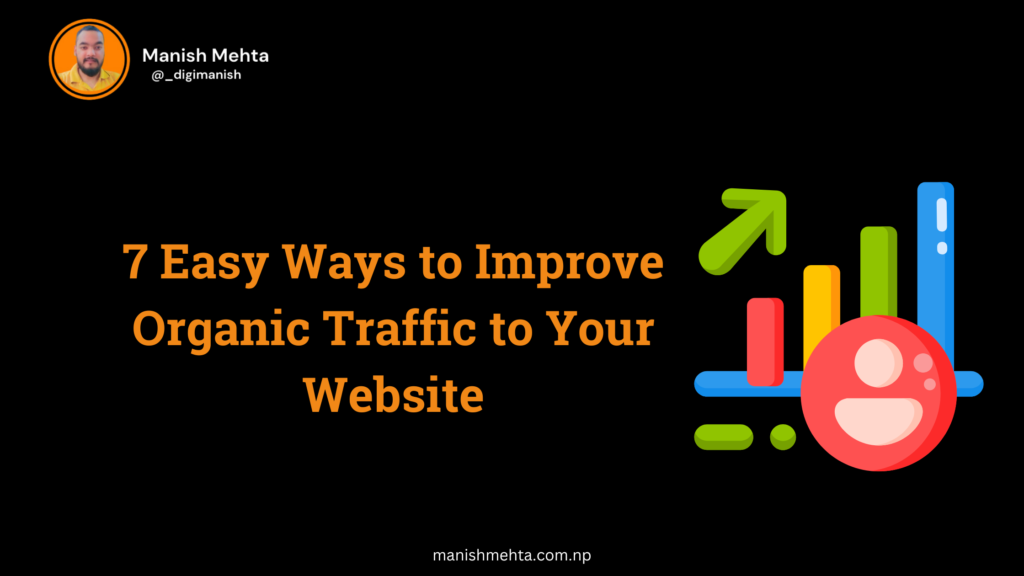Boosting organic traffic is a top priority for website owners, bloggers, and businesses. The challenge is doing it in an effective, sustainable way without resorting to paid ads. Organic traffic refers to visitors that come to your website from unpaid search engine results, and the benefits are undeniable—higher credibility, increased trust, and long-term results. If you’re looking to grow your website traffic, here are seven easy ways to improve organic traffic.

1. Optimize Your Content for Search Intent
Understanding user intent is key to attracting relevant organic traffic. Search intent refers to the reason behind a search query—whether users are looking for information, a product, or a solution to a problem. By optimizing your content to meet the needs of your audience, you align it with their search intent.
- How to do it: Use tools like Google’s “People Also Ask” feature, AnswerThePublic, and Google Trends to discover what people are searching for. Create content that addresses common questions, provides value, and solves problems.
- Example: If you’re running a blog about fitness, write content like “Best Workouts for Weight Loss” or “How to Build Muscle Without Equipment” to address popular queries.
2. Perform Comprehensive Keyword Research
Keyword research is the foundation of a successful SEO strategy. It helps you find the specific words and phrases that users are typing into search engines. By incorporating these keywords into your content, you increase the likelihood of appearing in search results.
- How to do it: Use keyword tools like SEMrush, Ahrefs, or Google Keyword Planner to identify relevant keywords with high search volumes and low competition. Focus on long-tail keywords (phrases containing 3-5 words) as they typically attract more qualified traffic.
- Example: Instead of just targeting “website design,” you could optimize for “affordable website design services for small businesses.”
3. Improve Your On-Page SEO
On-page SEO refers to optimizing individual pages of your website for search engines and users. It includes everything from title tags, meta descriptions, and headers to keyword placement, internal linking, and image alt texts.
- How to do it: Ensure each page has a compelling title tag (50-60 characters), a meta description (150-160 characters), and headers (H1, H2, H3) that are keyword-optimized. Include internal links to other pages on your website to help search engines understand your site structure and improve user navigation.
- Example: On a product page, include relevant internal links such as “Related Products” or “You May Also Like” to improve user engagement and keep them on your site longer.
4. Create High-Quality, Engaging Content
Search engines prioritize websites that produce high-quality, relevant content. Content that educates, informs, and engages your audience is more likely to rank well and get shared, leading to higher organic traffic.
- How to do it: Focus on creating content that offers real value, whether it’s a how-to guide, a case study, or a product review. Update your content regularly to keep it fresh and accurate. Aim for longer-form content (1,500-2,000 words), which often ranks higher in search results.
- Example: If you run a travel blog, create comprehensive guides like “The Ultimate Travel Guide to Japan,” complete with tips, places to visit, and insider advice.
5. Leverage Social Media to Boost Content Visibility
While social media traffic isn’t considered organic by Google, sharing your content on social platforms increases its visibility and can lead to more inbound links and organic visits. Social signals can indirectly impact your search engine rankings by driving traffic and engagement to your site.
- How to do it: Share your blog posts, product pages, or service offerings across all relevant social media channels. Encourage users to share your content, which can create a ripple effect and bring more visitors to your site.
- Example: Use Twitter, Instagram, LinkedIn, or Pinterest to promote your content and engage with users in your niche. If your post resonates, it could go viral, leading to a surge in organic traffic.
6. Build High-Quality Backlinks
Backlinks are one of the most important factors for improving organic traffic. A backlink is when another website links to your content. Search engines see backlinks as a vote of confidence, signaling that your content is valuable and trustworthy.
- How to do it: Focus on earning backlinks from reputable websites in your industry. You can do this by creating shareable content like infographics, guest posting on relevant blogs, and reaching out to influencers for collaborations.
- Example: Write a guest post on a high-authority website that links back to your site. This can boost your domain authority and help your pages rank higher in search engine results.
7. Optimize for Mobile and Page Speed
With more users accessing websites on their smartphones, optimizing your website for mobile is essential. In addition, page speed is a critical factor in SEO—users will leave your site if it takes too long to load, and search engines may penalize slow-loading websites.
- How to do it: Use Google’s Mobile-Friendly Test tool to ensure your website is responsive and mobile-friendly. Compress images, use lazy loading, and enable browser caching to improve page speed.
- Example: If your website loads slowly, a quick fix would be optimizing your image sizes. For instance, compress a 2MB image to under 100KB without losing quality.
Conclusion
Improving your website’s organic traffic doesn’t have to be complicated. By understanding your audience, optimizing your content for search engines, and providing high-quality, engaging content, you’ll naturally attract more visitors. Implement these seven strategies—focusing on search intent, keyword research, on-page SEO, and more—and watch your organic traffic grow over time.